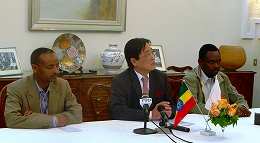|

|
|

|
Two Grassroots Human Security Projects Signed by Japan for School Construction in OROMIA |
 On 1 November 2010, a signing ceremony for Japanese Grant Assistance for Grassroots Human Security Projects (GGP) in JFY 2010 took place at the Japanese Ambassador’s Residence. Two Ethiopian non-profit organizations were invited as project partners to the ceremony. They are the Dejatch Balcha Aba Nefso Elementary School and the Soddo Agemgay Gerbo Elementary School. Both projects are to extend grants for secondary school construction in Oromia, which are directly beneficial for the residents. On 1 November 2010, a signing ceremony for Japanese Grant Assistance for Grassroots Human Security Projects (GGP) in JFY 2010 took place at the Japanese Ambassador’s Residence. Two Ethiopian non-profit organizations were invited as project partners to the ceremony. They are the Dejatch Balcha Aba Nefso Elementary School and the Soddo Agemgay Gerbo Elementary School. Both projects are to extend grants for secondary school construction in Oromia, which are directly beneficial for the residents.
H.E. Hiroyuki KISHINO, Ambassador of Japan to Ethiopia, assured the gathering that improved access to education would bring a variety of benefits in all aspects of life, including job opportunities, efficiency in agriculture, better health conditions, etc. This broadening of educational opportunities also leads to improvement in quality of life, not only at the individual level but also at the national level. In particular, His Excellency showed his eagerness to promote better access to secondary education in rural Ethiopia, where there is strong need for it as plenty of students are anxious to study but do not have appropriate secondary schools nearby. His Excellency also stressed that the project partners of GGP should complete the projects on schedule and ensure that the benefits would be brought to the residents in the local communities. The Government of Japan has been active in extending ODA (Official Development Assistance) to Ethiopia for many years. In the last Japanese fiscal year (JFY) 2009, the total amount of ODA Japan extended to Ethiopia amounted to USD 96 million as compared with USD 53 million in JFY 2007, which included bilateral assistance and ODA routed through multilateral organizations. Japan has placed priority on human security for vulnerable and marginalized people in society, and the Grassroots Human Security Grant has played a valuable role to help such people throughout Ethiopia. One of the characteristics of GGP is that it is directly beneficial to local residents. The GGP scheme was first introduced in 1989, and it thus has a history of 21 years to date. For the past 12 years, since 1997, over 270 projects have been implemented under this scheme in such sectors as education, water supply, health services, food and the provision of other basic human needs. In Woliso Woreda, the population has been increasing dramatically and the number of students as well in recent years. There is only one secondary school (G9-10) in Woliso Woreda, while there are 48 primary schools and over 175,000 students there. Due to the lack of secondary schools, most students who desire to study further have to go to another town, which is over 30 to 50 km away from Korke village and Soddo village respectively. However, most families are small-scale farmers and cannot afford to send their children for further education due to the expense involved. On the other hand, the children are concerned about their future lives due to the lack of land as a result of the high population density. In order to alleviate their problems, these projects aim to expand secondary education for those who desire to study more and whose families want their children to have further education. Dejatch Balcha Aba Nefso Elementary School (USD 106,346)
|
|
|